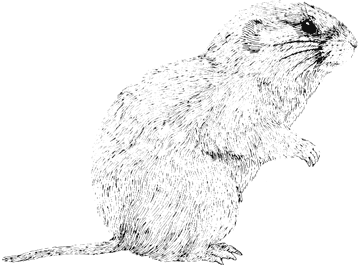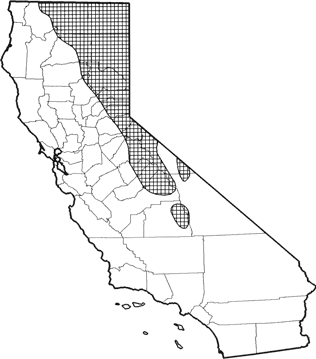
Montane Vole
Distribution, Abundance, and Seasonality
The montane vole in California is found in the Sierra Nevada, Cascades, and Great Basin regions from the Oregon border south to eastern Tulare Co., and in the White Mts. of Mono and Inyo cos. Common to abundant in wet meadow, perennial grassland, and alpine dwarf-shrub habitats. Also may be common in herbaceous understory of many forest habitats, as well as sagebrush, bitterbrush, annual grassland, and cropland habitats. Elevational range from 1500-3800 m (5000-12,000 ft).

Range Map
Specific Habitat Requirements
Feeding: Feeds on succulent stems and leaves of a wide variety of grasses, sedges, rushes, and forbs. Forages on the ground surface and underground. Cropping of grasses by voles may occur under some conditions (Berger et al. 1977).
Cover: Seeks cover in dense herbaceous growth. Constructs runways in grass. Underground burrows are constructed in friable soil. In winter, nests are found on the ground surface.
Reproduction: A nest of dried grasses is constructed in a burrow excavated in moist soil.
Water: Probably requires drinking water.
Pattern: Requires moderately dense herbaceous growth for cover. Prefers meadows or grasslands with a water source.
Species Life History
Activity Patterns: Active yearlong. Mainly nocturnal, but may be active at any time.
Seasonal Movements / Migration: None.
Home Range: In Montana, home ranges averaged about 0.1 ha (0.25 ac) (Douglass 1976). Reported densities range up to 550/ha (220/ac), and fluctuate considerably from year to year.
Territory: Females are intra- and interspecifically territorial, defending a radius of 30 m (100 ft) around the nest (Stroeker 1972, Jannett 1982). Males were not territorial in a Montana study (Stroeker 1972), but some males were territorial in a Wyoming study (Jannett 1982).
Reproduction: Mating may occur yearlong, but probably restricted to March-November at high elevations. Mated pairs do not share a nest. Gestation is 21 days. Litter sizes usually 5-6, ranging from 1-10. There may be 1-5, or more, litters per yr. The young wean at about 3 wk, and females may be sexually mature soon after weaning. Males probably sexually mature after several mos. Individuals from late summer litters reproduce for the first time the following spring. At low densities, females abandon the nest and young after weaning. At high densities, extended maternal families are formed in which a female may inhabit the nest with 2 successive litters. Green vegetation stimulates reproduction; dry, mature vegetation inhibits reproduction (Berger et al. 1977, Negus et al. 1977, Jannett 1978, 1982).
Niche: Predators include owls, hawks, weasels, snakes, coyotes, and bobcats. At high densities, M. montanus excludes M. Iongicaudus from grassy habitat (Randall and Johnson 1979).
Comments: Maintain grassy areas and prevent overgrazing to protect populations.
Sources & References
California Department of Fish and Game, 1999.
California's Wildlife, Sacramento, CA.
Written by: P. Brylski, reviewed by: H. Shellhammer, edited by: R. Duke, J. Harris
Anderson, S. 1959. Distribution, variation, and relationships of the montane vole, Microtus montanus. Univ. Kansas Publ., Mus. Nat. Hist. 9:415-511. Berger, P. J., E. H. Sanders, P. D. Gardner, and N. C. Negus. 1977. Phenolic plants compounds functioning as reproductive inhibitors in Microtus montanus. Science 195:575-577. Douglass, R. J. 1976. Spatial interactions and microhabitat selections of two locally sympatric voles, Microtus montanus and Microtus pennsylvanicus. Ecology 567:346-352. Jannett, F. J., Jr. 1978. The density-dependent formation of extended maternal families of the montane vole, Microtus montanus nanus. Behav. Ecol. Sociobiol. 3:245-263. Jannett, F. J., Jr. 1982. Nesting patterns of adult voles, Microtus montanus, in field populations. J. Mammal. 63:495-498. Jenkins, H. O. 1948. A population study of the meadow mice (Microtus) in three Sierra Nevada meadows. Proc. Calif. Acad. Sci. 26:43-67. Negus, N. C., P. J. Berger, and L. G. Forslund. 1977. Reproductive strategy of Microtus montanus. J. Mammal. 58:347-353. Randall, J. A., and R. E. Johnson. 1979. Population densities and habitat occupancy by Microtus longicaudus and M. montanus. J. Mammal. 60:217-219. Stroeker, R. E. 1972. Competitive relations between sympatric populations of voles (Microtus montanus and M. pennsylvanicus). J. Anim. Ecol. 41:311-329.
California Animal Facts | California's Wildlife